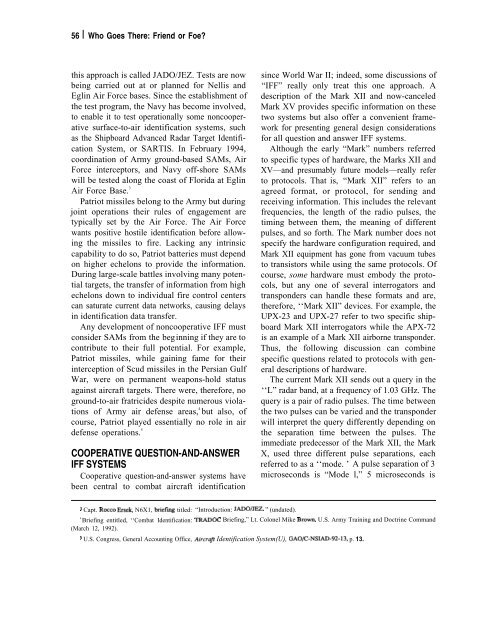Who Goes There: Friend or Foe? - Federation of American Scientists
Who Goes There: Friend or Foe? - Federation of American Scientists
Who Goes There: Friend or Foe? - Federation of American Scientists
Create successful ePaper yourself
Turn your PDF publications into a flip-book with our unique Google optimized e-Paper software.
56 I <strong>Who</strong> <strong>Goes</strong> <strong>There</strong>: <strong>Friend</strong> <strong>or</strong> <strong>Foe</strong>?<br />
this approach is called JADO/JEZ. Tests are now<br />
being carried out at <strong>or</strong> planned f<strong>or</strong> Nellis and<br />
Eglin Air F<strong>or</strong>ce bases. Since the establishment <strong>of</strong><br />
the test program, the Navy has become involved,<br />
to enable it to test operationally some noncooperative<br />
surface-to-air identification systems, such<br />
as the Shipboard Advanced Radar Target Identification<br />
System, <strong>or</strong> SARTIS. In February 1994,<br />
co<strong>or</strong>dination <strong>of</strong> Army ground-based SAMs, Air<br />
F<strong>or</strong>ce intercept<strong>or</strong>s, and Navy <strong>of</strong>f-sh<strong>or</strong>e SAMs<br />
will be tested along the coast <strong>of</strong> Fl<strong>or</strong>ida at Eglin<br />
Air F<strong>or</strong>ce Base. 3<br />
Patriot missiles belong to the Army but during<br />
joint operations their rules <strong>of</strong> engagement are<br />
typically set by the Air F<strong>or</strong>ce. The Air F<strong>or</strong>ce<br />
wants positive hostile identification bef<strong>or</strong>e allowing<br />
the missiles to fire. Lacking any intrinsic<br />
capability to do so, Patriot batteries must depend<br />
on higher echelons to provide the inf<strong>or</strong>mation.<br />
During large-scale battles involving many potential<br />
targets, the transfer <strong>of</strong> inf<strong>or</strong>mation from high<br />
echelons down to individual fire control centers<br />
can saturate current data netw<strong>or</strong>ks, causing delays<br />
in identification data transfer.<br />
Any development <strong>of</strong> noncooperative IFF must<br />
consider SAMs from the beginning if they are to<br />
contribute to their full potential. F<strong>or</strong> example,<br />
Patriot missiles, while gaining fame f<strong>or</strong> their<br />
interception <strong>of</strong> Scud missiles in the Persian Gulf<br />
War, were on permanent weapons-hold status<br />
against aircraft targets. <strong>There</strong> were, theref<strong>or</strong>e, no<br />
ground-to-air fratricides despite numerous violations<br />
<strong>of</strong> Army air defense areas, 4<br />
but also, <strong>of</strong><br />
course, Patriot played essentially no role in air<br />
defense operations. 5<br />
COOPERATIVE QUESTION-AND-ANSWER<br />
IFF SYSTEMS<br />
Cooperative question-and-answer systems have<br />
been central to combat aircraft identification<br />
q Capt. Rocco Erse~ N6X1, brief~ titled: “Introduction: JADO/JEZ, ” (undated).<br />
since W<strong>or</strong>ld War II; indeed, some discussions <strong>of</strong><br />
“IFF” really only treat this one approach. A<br />
description <strong>of</strong> the Mark XII and now-canceled<br />
Mark XV provides specific inf<strong>or</strong>mation on these<br />
two systems but also <strong>of</strong>fer a convenient framew<strong>or</strong>k<br />
f<strong>or</strong> presenting general design considerations<br />
f<strong>or</strong> all question and answer IFF systems.<br />
Although the early “Mark” numbers referred<br />
to specific types <strong>of</strong> hardware, the Marks XII and<br />
XV—and presumably future models—really refer<br />
to protocols. That is, “Mark XII” refers to an<br />
agreed f<strong>or</strong>mat, <strong>or</strong> protocol, f<strong>or</strong> sending and<br />
receiving inf<strong>or</strong>mation. This includes the relevant<br />
frequencies, the length <strong>of</strong> the radio pulses, the<br />
timing between them, the meaning <strong>of</strong> different<br />
pulses, and so f<strong>or</strong>th. The Mark number does not<br />
specify the hardware configuration required, and<br />
Mark XII equipment has gone from vacuum tubes<br />
to transist<strong>or</strong>s while using the same protocols. Of<br />
course, some hardware must embody the protocols,<br />
but any one <strong>of</strong> several interrogat<strong>or</strong>s and<br />
transponders can handle these f<strong>or</strong>mats and are,<br />
theref<strong>or</strong>e, ‘‘Mark XII” devices. F<strong>or</strong> example, the<br />
UPX-23 and UPX-27 refer to two specific shipboard<br />
Mark XII interrogat<strong>or</strong>s while the APX-72<br />
is an example <strong>of</strong> a Mark XII airb<strong>or</strong>ne transponder.<br />
Thus, the following discussion can combine<br />
specific questions related to protocols with general<br />
descriptions <strong>of</strong> hardware.<br />
The current Mark XII sends out a query in the<br />
‘‘L” radar band, at a frequency <strong>of</strong> 1.03 GHz. The<br />
query is a pair <strong>of</strong> radio pulses. The time between<br />
the two pulses can be varied and the transponder<br />
will interpret the query differently depending on<br />
the separation time between the pulses. The<br />
immediate predecess<strong>or</strong> <strong>of</strong> the Mark XII, the Mark<br />
X, used three different pulse separations, each<br />
referred to as a ‘‘mode. ’ A pulse separation <strong>of</strong> 3<br />
microseconds is “Mode l,” 5 microseconds is<br />
4<br />
Briefing entitled, ‘‘Combat Identification: TRADOC Briefing,” Lt. Colonel Mike Bro~ U.S. Army Training and Doctrine Command<br />
(March 12, 1992).<br />
5 U.S. Congress, General Accounting Office, Aircrajl Identification System(U), GAO/C-NSIAD-92-13, p. 13.
















